Abstract
This experiment to search for the one of the charged lepton flavor-violating processes, muon-electron conversion, DeeMe, is being conducted at the J-PARC MLF H-Line in Japan. This experiment utilizes a pulsed proton beam from the Rapid Cycling Synchrotron (RCS). A graphite target is bombarded with a pulsed proton beam, negative pion production and pion-in-flight-decay to negative muon; then, the creation of muonic atoms is caused in the same pion production target. A converted electron is expected to be emitted after 1 ∼ 2 micro second-delayed timing. And two-body reaction of the new process, , results in 105 MeV monoenergetic electron. Thus, 1 ∼ 2 micro second-delayed 105 MeV monoenergetic electron is a searched signal. Electrons around 105 MeV are transported by the H-Line and analyzed using the dipole magnet (0.4 T) and four multi-wire proportional chambers (MWPCs). However, the burst pulse reaching charged particles/pulse attributable to the RCS pulse leads to significant dead time for the MWPC. Thus, the HV switching scheme is introduced to handle the prompt burst. The target single event sensitivity is . The H-Line construction was completed, and commissioning went well. The overview of the experiment and the current status are described in this article.
1. Introduction
1.1. Charged Lepton Flavor Violation
Lepton flavor violation is forbidden in the original standard model. Since the neutrino oscillation was discovered, it has been found that the flavor violation of neutral lepton occurs. But the charged lepton flavor violation (CLFV) such as , , (N is a nucleus) has not been discovered yet. On the other hand, charged lepton flavor violation induced by neutrino flavor mixing is possible. However, for example, the branching fraction of becomes ; thus, it is too small to be observed experimentally in the framework of the standard model. Therefore, experimental observation of the CLFV process is clear evidence of the new physics beyond the standard model. There are some theoretical models beyond the standard model which predict the enhancement of the charged lepton flavor violation, such as SUSY GUT, SUSY-seesaw, and doubly charged Higgs, among others. And the predicted branching fraction of CLFV in those models is , which is a sizable branching fraction. The current upper limits for the CLFV processes from experiments are range from to . So, a new experimental search with sensitivity under should be started in a timely manner.
1.2. Muonic Atoms
When stops in the matter, is captured by a nucleus, and a muonic atom (1S) is created. In the framework of the standard model, muon decay in orbit (DIO), , occurs with 92% for C and 33% for Si. Another process in the standard model is muon capture, , with 8% for C and 66% for Si. And the lifetimes are 2.0 s and 0.7 s, respectively. On the other hand, as a new physics, muon–electron conversion in the nuclear field, , is expected to occur. This is a charged lepton flavor violation process. Since this is a two-body process, an electron is monoenergetic around 105 MeV. Also, the signal is delayed by ∼2 s.
2. DeeMe Experiment
This experiment to search for muon-electron conversion, DeeMe, is conducted at J-PARC Materials and Life Science Experimental Facility (MLF) (Figure 1). We use a high-purity pulsed proton beam from the 3-GeV Rapid Cycling Synchrotron (RCS) [1]. The beam is a fast extracted one and the power is currently 830 kW, which is upgraded to 1 MW. Also, the beam consists of 25 Hz double pulses. DeeMe is performed at the H-Line [2], a newly built large-acceptance beamline for fundamental physics. The H-Line construction was completed in January 2022. As shown in Figure 2, in the DeeMe experiment, negative pion production, pion-in-flight-decay to negative muon and muon stopping happen inside the same production target made from graphite. We utilize muonic atoms formed in the pion production target. This means we have no pion decay volume and no additional stopping target. This is contrast to the conventional muon–electron conversion search experiment. Using the secondary beamline, we transport the signal electrons of 105 MeV/c. The momentum is selected by the beamline, and the low-momentum background is suppressed. Using the magnet spectrometer, we analyze the particle momentum and identify the signal electrons. The spectrometer consists of a dipole magnet (PACMAN; 0.4 T) and multi-wire proportional chambers (MWPCs).
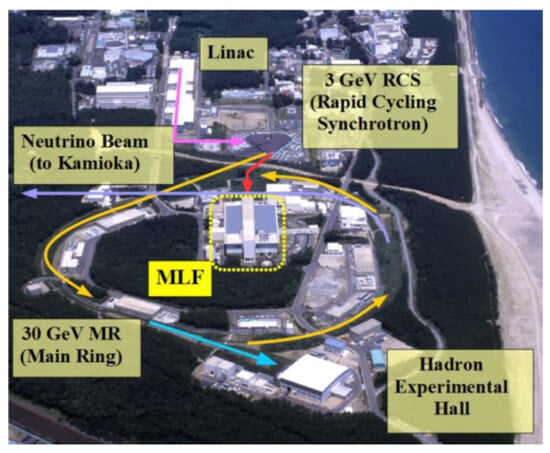
Figure 1.
Photo of an overall perspective of J-PARC.
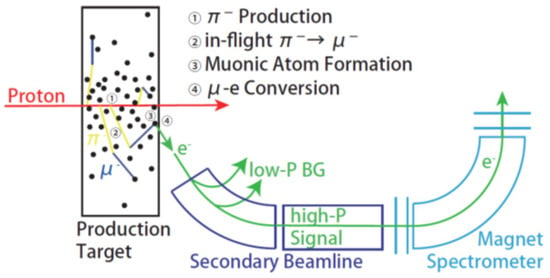
Figure 2.
Schematic of the DeeMe experiment.
Figure 3 shows the beam structure and the time window for analysis. We use a pulsed proton beam by 25 Hz of double pulse, of which each width is 200 ns, and the time interval is 600 ns. In order to reject the prompt burst, the time window for analysis is set at 300 ns after the second pulse.
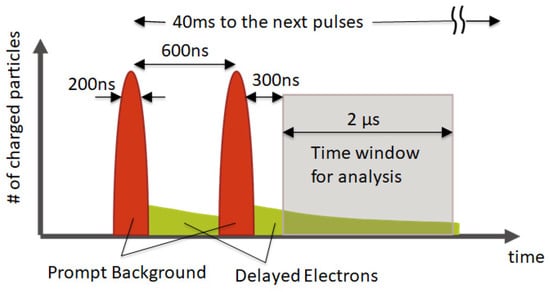
Figure 3.
Beam structure and the time window for analysis.
The current upper limits for muon–electron conversion are [3] for a titanium target obtained via the experiment at TRIUMF, [4] for a titanium target and [5] for a gold target obtained via the SINDRUM-II experiment at PSI. We aim to achieve the single event sensitivity of for a graphite target with 1-year run (2 × s) with 1 MW primary proton beam to observe the CLFV or to improve the current limit by one order of magnitude.
3. HV Switching MWPC
Protons hitting the production target produce a lot of electrons in the prompt timing. The detector is required to tolerate the prompt burst beam bunch of charged particles. Instantaneous hit rate on the detector is expected to be approximately 70 GHz/mm. Also, the detector should return to operational 300 ns after the beam pulse to detect delayed electrons. Therefore, we have developed an HV switching MWPC [6,7]. In this scheme, anode wires and potential wires are aligned alternately with a pitch of 0.7 mm in a plane between cathodes as shown in Figure 4. The chamber gas is a mixture of Ar, iso-butane, and methylal with a ratio of 75:15:10. Anode wires are always set around 1500 V, and we switch the voltage for potential wires. The potential wires are set at the same voltage as the anode wires as a usual state, the detector is protected during the burst, and no space charge is created. The gas gain is in the order of 1. And the potential wires are set at 0 V in the analysis time window after the prompt burst to detect a delayed signal. The gas gain is in the order of as shown in Figure 5. The hit information is read out from cathode strips through amplifiers with large current tolerance [8] and 10-bit flash analog-to-digital converters (FADCs) with a sampling rate of 100 MHz [9].

Figure 4.
Cross sectional view of the HV switching MWPC.

Figure 5.
Gas gain for the analysis time window.
4. Background
As for background, considering the running time of s (1-year data acquisition period), the decay-in-orbit background is estimated to be 0.09, and the after-proton-induced background, which is produced from extracted protons at kick-off time, is estimated to be less than 0.027. Regarding the cosmic backgrounds, due to the small detector live-time duty of 1/20,000, the electron background is less than 0.018 and the muon background is less than 0.001. The beam pion capture background, which is created the following reaction,
comes the prompt timing and is restricted to 0.0009 by the delayed analysis time window.
5. Current Status
The H-Line construction was completed in January 2022, and the DeeMe commissioning runs were performed in June 2022. In the commissioning run, every system including the gas supply and circulation system and the data acquisition system worked well. Figure 6 shows the MWPCs and PACMAN in the H1 area. Figure 7 shows a beam profile of the prompt burst 105 MeV/c electrons. DeeMe is ready to take physics data. We made a quick data analysis for a positron dataset at 50 MeV/c for Michel edge measurement. Positron momentum was reconstructed successfully, as shown in Figure 8.
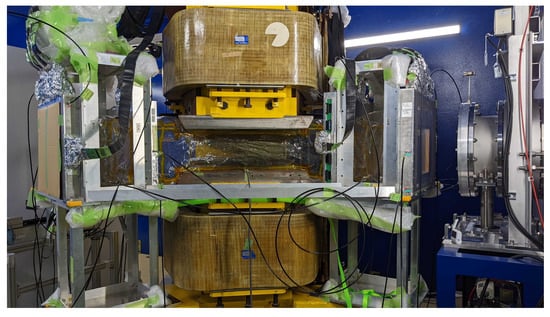
Figure 6.
Four MWPCs and a dipole magnet (PACMAN) in the H1 area. The beam comes from the right side.
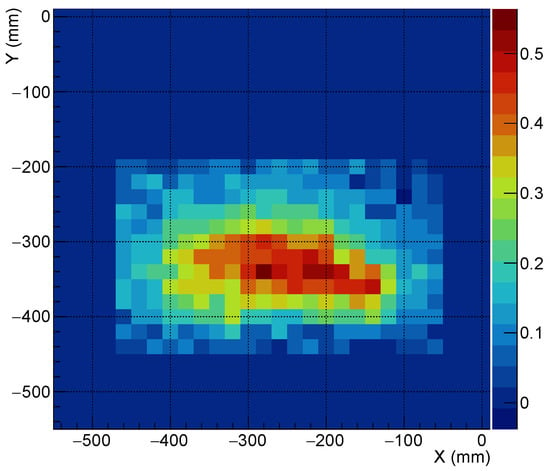
Figure 7.
Beam−profile for 105 MeV/c electrons.
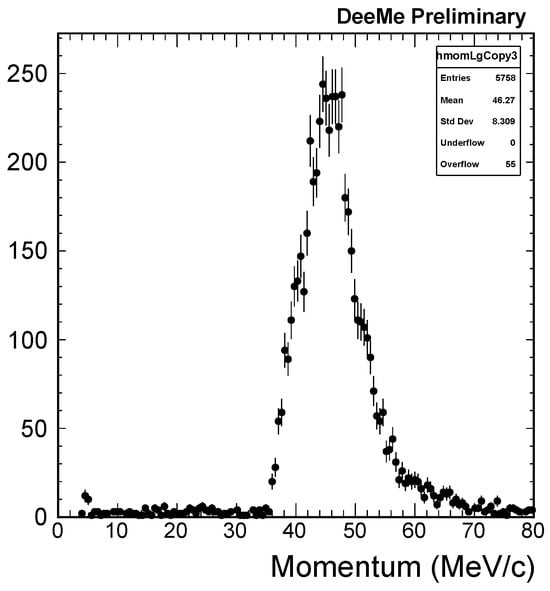
Figure 8.
Reconstructed momentum spectrum for a positron dataset at 50 MeV/c.
6. Summary
The DeeMe experiment at J-PARC MLF is conducted to search for the muon–electron conversion process in the nuclear field with a target single event sensitivity of . The detector needs to be tolerant of high-rate prompt burst and to be able to detect a signal electron for muon–electron conversion soon after T prompt burst charged particles produced by the pulsed proton beam. We have developed an HV switching MWPC to satisfy the above requirements. We are ready to take physics data.
Funding
This research was funded by JSPS KAKENHI grant number JP21654034, JP24224006, JP17H01128.
Institutional Review Board Statement
Not applicable.
Informed Consent Statement
Not applicable.
Data Availability Statement
Not applicable.
Conflicts of Interest
The authors declare no conflict of interest.
References
- Yamamoto, K.; Kinsho, M.; Hayashi, N.; Saha, P.K.; Tamura, F.; Yamamoto, M.; Tani, N.; Takayanagi, T.; Kamiya, J.; Shobuda, Y.; et al. Design and actual performance of J-PARC 3 GeV rapid cycling synchrotron for high-intensity operation. J. Nucl. Sci. Tech. 2022, 59, 1174. [Google Scholar] [CrossRef]
- Kawamura, N.; Aoki, M.; Doornbos, J.; Mibe, T.; Miyake, Y.; Morimoto, F.; Nakatsugawa, Y.; Otani, M.; Saito, N.; Seiya, Y.; et al. New concept for a large-acceptance general-purpose muon beamline. Prog. Theor. Exp. Phys. 2018, 2018, 113G01. [Google Scholar] [CrossRef]
- Ahmad, S.; Azuelos, G.; Blecher, M.; Bryman, D.A.; Burnham, R.A.; Clifford, E.T.H.; Depommier, P.; Dixit, M.S.; Gotow, K.; Hargrove, C.K.; et al. Search for muon-electron and muon-positron conversion. Phys. Rev. D 1988, 38, 2102. [Google Scholar] [CrossRef] [PubMed]
- Dohmen, C.; Groth, K.D.; Heer, B.; Honecker, W.; Otter, G.; Steinruecken, B.; Wintz, P.; Dzhordzhadze, B.; Hofmann, J.; Kozlowski, T.; et al. Test of lepton-flavour conservation in μ→e conversion on titanium. Phys. Lett. B 1993, 317, 631. [Google Scholar] [CrossRef]
- Bertl, W.; Engfer, R.; Hermes, E.; Kurz, G.; Kozłowski, T.; Kuth, J.; Otter, G.; Rosenbaum, F.; Ryskulov, N.; Schaaf, A.; et al. A search for μ − e conversion in muonic gold. Eur. Phys. J. C 2006, 47, 337. [Google Scholar] [CrossRef]
- Natori, H.; Teshima, N.; Aoki, M.; Nishiguchi, H.; Takezaki, Y.; Furuya, Y.; Ito, S.; Mihara, S.; Nagao, D.; Nakatsugawa, Y.; et al. A fast high-voltage switching multiwire proportional chamber. Prog. Theor. Exp. Phys. 2017, 2017, 023C01. [Google Scholar] [CrossRef]
- Teshima, N.; Aoki, M.; Higashino, Y.; Ikeuchi, H.; Komukai, K.; Nagao, D.; Nakatsugawa, Y.; Natori, H.; Seiya, Y.; Truong, N.; et al. Development of a multiwire proportional chamber with good tolerance to burst hits. Nucl. Instrum. Methods Phys. Res. A 2021, 999, 165228. [Google Scholar] [CrossRef]
- Teshima, N. Development of a high-rate tolerant HV-switching multi-wire proportional chamber and its read electronics for DeeMe experiment. In Proceedings of the FPCP2015 Conference, POS(FPCP2015) 061, Nagoya, Japan, 25–29 May 2015. [Google Scholar]
- Truong, N.M.; Aoki, M.; Igarashi, Y.; Saito, M.; Ito, S.; Nagao, D.; Nakatsugawa, Y.; Natori, H.; Seiya, Y.; Teshima, N.; et al. Real-Time Lossless Compression of Waveforms Using an FPGA. IEEE Trans. Nucl. Sci. 2018, 65, 2650. [Google Scholar] [CrossRef]
Disclaimer/Publisher’s Note: The statements, opinions and data contained in all publications are solely those of the individual author(s) and contributor(s) and not of MDPI and/or the editor(s). MDPI and/or the editor(s) disclaim responsibility for any injury to people or property resulting from any ideas, methods, instructions or products referred to in the content. |
© 2023 by the author. Licensee MDPI, Basel, Switzerland. This article is an open access article distributed under the terms and conditions of the Creative Commons Attribution (CC BY) license (https://creativecommons.org/licenses/by/4.0/).